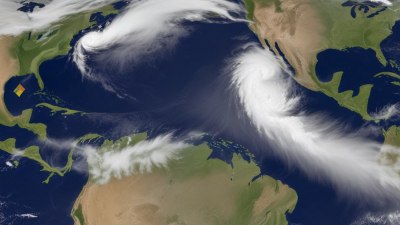The Oldest Weather Records Ever Kept and What They Reveal About Our Climate
Explore ancient weather records and their insights on climate change over centuries.

This image was created with the assistance of Freepik
The history of weather recording stretches back centuries, with some of the oldest records revealing significant insights into climate patterns and changes. These records serve as invaluable tools for scientists and historians alike, shedding light on how our planet's climate has evolved over time.
Early weather records date back to ancient civilizations, where methods of tracking seasonal changes were crucial for agriculture and survival. The ancient Greeks, for instance, made early attempts to record weather patterns, documenting temperatures and precipitation in texts like those of Aristotle. His work in 'Meteora' laid a foundation for observational meteorology that would influence scientific thought for millennia.
Ancient Civilizations and Their Records
In ancient China, meticulous weather observations were kept, especially during the Han Dynasty (206 BC – 220 AD). The Chinese developed early forms of meteorology, correlating weather and agriculture cycles, and recorded events such as floods and droughts. These records not only reflect weather changes but also societal impacts of climate, illustrating the relationship between environmental conditions and human activity.
Similarly, the Egyptians documented the annual flooding of the Nile River, which was critical for their agriculture. These accounts provide a perfect benchmark for understanding climatic variances over the millennia. Through centuries of records, historians and climate scientists can reconstruct changing rainfall patterns and temperature fluctuations.
Medieval Climate Periods
The Medieval Warm Period (approximately 950 to 1250 AD) is one such epoch identified through ancient records. This period is characterized by higher-than-average temperatures in the Northern Hemisphere, leading to longer growing seasons in Europe. The repercussions of this warming manifested in agricultural prosperity but also set the stage for later climatic shifts.
In contrast, the Little Ice Age (approximately 1300 to 1850 AD), a period noted for colder temperatures, severely impacted global weather patterns. Records from this time reflect harsh winters and altered agricultural yields, leading to food shortages and social unrest across Europe and other regions. These fluctuations illustrate how climate variations can drive societal changes and historical events.
Modern Evaluations of Ancient Records
The study of these ancient weather records has employed various scientific techniques. Paleoclimatology, for instance, utilizes proxy data such as tree rings, ice cores, and sediment layers in addition to written records to gauge historical climate conditions. This comprehensive approach helps build a clearer picture of climatic trends over thousands of years.
Tree rings are particularly valuable, with each year's growth reflecting the environmental conditions. A wider ring indicates favorable conditions, while a narrower one signifies stress due to drought or cold temperatures. These analyses have confirmed the historical records of warmer periods and have highlighted the complex interplays in climate dynamics.
Impacts of Climate Change
Modern implications of studying ancient weather records cannot be overstated. As we face unprecedented changes in climate today, understanding historical patterns provides context for present and future shifts. With rising global temperatures and increased frequency of extreme weather events, ancient records serve as a benchmark against which current changes can be measured.
Research indicates that current warming is occurring at a rate not seen in the past millennia. By examining records that span centuries, scientists can discern if today's changes are part of a natural cycle or if they are the result of human influence. The evidence suggests that while climate has always varied, the current trajectory is alarming and poses significant risks for ecosystems and human societies.
Looking Ahead: The Importance of Long-Term Data
The importance of maintaining long-term weather databases cannot be overstated. As the impacts of climate change continue to unfold, having rich historical data allows scientists to validate models and predict future trends. This long-view approach is critical, as it helps differentiate between natural fluctuations and those induced by anthropogenic factors.
The collaboration of various fields, including history, meteorology, and environmental science, is essential in helping society understand and respond to climate change. By continuing to study ancient records and integrating these findings with modern technology, we can gain deeper insights into our climate’s future.
Lessons from the Past: How History Informs Climate Action
One crucial lesson from past climate records is the importance of adaptation. Historical records exhibit how societies have both adapted to and been adversely affected by climate variations. Successful responses often included innovations in agriculture, water management, and migration, while failures were marked by societal collapse and demographic shifts. Learning from these historical events can guide contemporary approaches to climate resilience.
Moreover, the analysis of ancient weather records emphasizes the interconnectedness of natural systems and human activities. Understanding how previous civilizations adapted to climate change can provide crucial insights into developing effective policies and sustainable practices today. Addressing climate change is not merely an environmental issue; it is intertwined with social, economic, and political factors that must be carefully managed.
The Enduring Value of Weather Records
As we navigate an era marked by climate uncertainty, the oldest weather records ever kept offer a wealth of information about our planet's historical climate changes. They are invaluable resources, enabling us to grasp the fabric of our global climate system and the forces shaping it. Ancient records remind us of the cyclical nature of climate and the various ways societies have responded to those changes.
In moving forward, it becomes imperative to not only continue documenting weather patterns but also to honor the knowledge of these historical records as we confront today's climate crises. Only by respecting the lessons of the past can we hope to build a resilient future for the generations to come.











